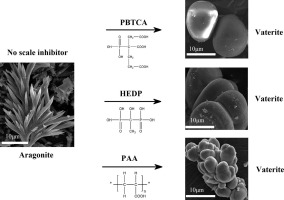当前位置:
X-MOL 学术
›
J. Colloid Interface Sci.
›
论文详情
Our official English website, www.x-mol.net, welcomes your
feedback! (Note: you will need to create a separate account there.)
Effect of scale inhibitors on the structure and morphology of CaCO3 crystal electrochemically deposited on TA1 alloy.
Journal of Colloid and Interface Science ( IF 9.4 ) Pub Date : 2019-11-19 , DOI: 10.1016/j.jcis.2019.11.078 Zhaoshun Zuo 1 , Wenzhong Yang 1 , Kegui Zhang 2 , Yun Chen 1 , Meng Li 1 , Yuwei Zuo 1 , Xiaoshuang Yin 1 , Ying Liu 1
Journal of Colloid and Interface Science ( IF 9.4 ) Pub Date : 2019-11-19 , DOI: 10.1016/j.jcis.2019.11.078 Zhaoshun Zuo 1 , Wenzhong Yang 1 , Kegui Zhang 2 , Yun Chen 1 , Meng Li 1 , Yuwei Zuo 1 , Xiaoshuang Yin 1 , Ying Liu 1
Affiliation

|
The deposition of CaCO3 scale in circulating cooling water on metal surface is a major concern in industry. This paper focuses on the feasibility of electrochemical methods to study the scale inhibition performance of 1-hydroxyethylidene-1,1-diphosphonic acid (HEDP) and 2-phosphonobutane-1,2,4-tricarboxylic acid (PBTCA), Polyacrylic Acid (PAA), including linear sweep voltammetry, chronoamperometry, and electrochemical impedance spectroscopy (EIS). In addition, the coverage, morphology and structure of deposited CaCO3 crystal on titanium alloy surface in the absence and presence of inhibitors were investigated by X-ray diffraction (XRD) and scanning electron microscopy (SEM). A new method for calculating the efficiency of scale inhibitors was proposed so that it can be calculated by using the change in residual current density (ir). In order to prove the feasibility and accuracy of such method, the efficiencies of inhibitors were evaluated using ir and charge transfer resistance (Rct), respectively. In addition, molecular dynamics (MD) simulations were performed to evaluate the interaction between the scale inhibitor molecule and the CaCO3 crystal. The experimental results show that both the residual current density obtained by chronoamperometry and the charge transfer resistance obtained by electrochemical impedance spectroscopy can be used to evaluate the efficiency of scale inhibitors, and there is high consistency from the calculation results. It is also confirmed by X-ray diffraction and scanning electron microscopy studies that the presence of inhibitor reduces the surface coverage of CaCO3 at metal electrode and that the crystal structure of CaCO3 is transformed from the original aragonite into the most unstable vaterite. The best inhibition efficiency of PBTCA for CaCO3 deposit is confirmed by the results of MD simulations.
中文翻译:

阻垢剂对电化学沉积在TA1合金上的CaCO3晶体结构和形态的影响。
CaCO 3垢在金属表面的循环冷却水中的沉积是工业中的主要关注点。本文重点研究了电化学方法研究1-羟基亚乙基-1,1-二膦酸(HEDP)和2-膦酰基丁烷-1,2,4-三羧酸(PBTCA),聚丙烯酸(PAA)的阻垢性能的可行性。 ),包括线性扫描伏安法,计时电流法和电化学阻抗谱(EIS)。此外,通过X射线衍射(XRD)和扫描电子显微镜(SEM)研究了在不存在抑制剂的情况下钛合金表面沉积的碳酸钙晶体的覆盖率,形貌和结构。提出了一种计算阻垢剂效率的新方法,以便可以利用剩余电流密度(ir)的变化进行计算。为了证明这种方法的可行性和准确性,分别使用ir和电荷转移阻力(Rct)评估了抑制剂的效率。此外,进行了分子动力学(MD)模拟以评估阻垢剂分子与CaCO3晶体之间的相互作用。实验结果表明,计时安培法测得的剩余电流密度和电化学阻抗谱法测得的电荷转移电阻均可用于评价阻垢剂的效率,计算结果具有较高的一致性。通过X射线衍射和扫描电子显微镜研究也证实,抑制剂的存在降低了CaCO 3在金属电极上的表面覆盖,并且CaCO 3的晶体结构从原始文石转变为最不稳定的球ate石。MD模拟的结果证实了PBTCA对CaCO3沉积的最佳抑制效果。
更新日期:2019-11-19
中文翻译:

阻垢剂对电化学沉积在TA1合金上的CaCO3晶体结构和形态的影响。
CaCO 3垢在金属表面的循环冷却水中的沉积是工业中的主要关注点。本文重点研究了电化学方法研究1-羟基亚乙基-1,1-二膦酸(HEDP)和2-膦酰基丁烷-1,2,4-三羧酸(PBTCA),聚丙烯酸(PAA)的阻垢性能的可行性。 ),包括线性扫描伏安法,计时电流法和电化学阻抗谱(EIS)。此外,通过X射线衍射(XRD)和扫描电子显微镜(SEM)研究了在不存在抑制剂的情况下钛合金表面沉积的碳酸钙晶体的覆盖率,形貌和结构。提出了一种计算阻垢剂效率的新方法,以便可以利用剩余电流密度(ir)的变化进行计算。为了证明这种方法的可行性和准确性,分别使用ir和电荷转移阻力(Rct)评估了抑制剂的效率。此外,进行了分子动力学(MD)模拟以评估阻垢剂分子与CaCO3晶体之间的相互作用。实验结果表明,计时安培法测得的剩余电流密度和电化学阻抗谱法测得的电荷转移电阻均可用于评价阻垢剂的效率,计算结果具有较高的一致性。通过X射线衍射和扫描电子显微镜研究也证实,抑制剂的存在降低了CaCO 3在金属电极上的表面覆盖,并且CaCO 3的晶体结构从原始文石转变为最不稳定的球ate石。MD模拟的结果证实了PBTCA对CaCO3沉积的最佳抑制效果。





















































 京公网安备 11010802027423号
京公网安备 11010802027423号